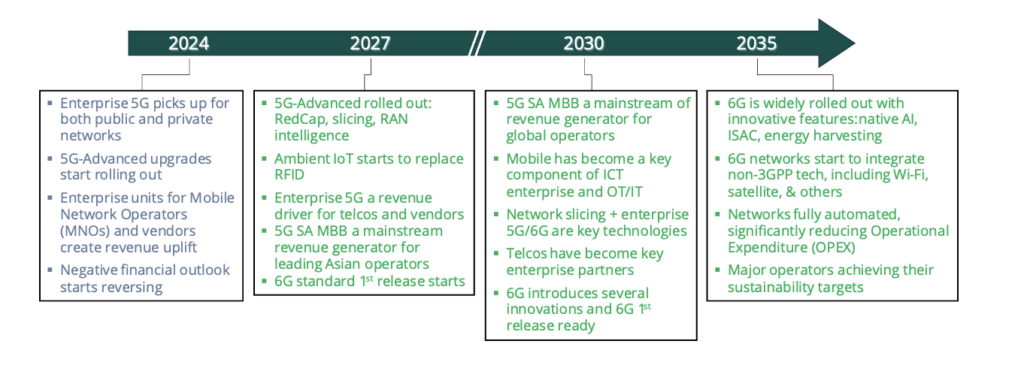On June 27, 2024, in Shanghai, China, a collaborative 6G Network Architecture Prospect seminar was held during which leading global mobile operators from China, Japan and South Korea convened to delve into the innovative architecture of 6G networks, signifying a constructive step forward in technological cooperation.
While some Western operators have experienced a much slower deployment of 5G Standalone (SA) and have yet to see the true potential of 5G, 5G SA deployment has yielded substantial Mobile Broadband (MBB) revenue for several leading Asian mobile operators. These operators have taken a proactive posture in 5G SA infrastructure rollout. As a result, many of these Asian operators, equipped with the requisite resources and ambition, are enthusiastic to spearhead the research and push forward the standardization process for 6G network architecture.
Visions of a 6G core
In her keynote speech, Xiaoyun Wang, chief scientist at China Mobile, recommended that a unified 6G standard would benefit the global mobile industry. Operators from Japan, South Korea and China have been very active in the past 3G/4G and 5G standardization work. The Chief Scientist proposed that operators should continue contributing to global 6G standards and maintain a leading innovation posture for the 6G era.
Following that, Xiaodong Duan, vice president of China Mobile Research Institute, announced the publication of its AI-agent Communication Network whitepaper. The whitepaper proposed the view that, with robust development of generative artificial intelligence (gen AI) technologies, the network elements managed and served by mobile networks will further incorporate not just human-centric devices and Internet of Things (IoT) devices, but also “AI agents,” which will help speed up mobile network upgrades and transformation.
Yoshitaka Hatanaka, Mmanager from NTT DOCOMO, presented the company’s 6G view and architecture. Four objectives for 6G were highlighted: 1) sustainable network design; 2) network for AI, machines and robotics; 3) the “essential and intrinsically connected” network; and 4) developing new business opportunities such as computing-network convergence and achieving zero network outages.
Regarding 6G architecture, concern was expressed that the number of architecture options should be reduced, as well the need to study aggregation of connections via 5G Radio Access Technology (RAT) and 6G RAT to achieve better throughput and a comprehensive assessment of core network aggregation. Lastly, the NTT DOCOMO Manager highlighted the need to simplify the number of Network Functions (NFs) in 6G Core (6GC).
Masaaki Koga, executive director at KDDI, emphasized the invaluable role of several existing 5G Core (5GC) network features, such as network slicing, network exposure function, edge computing, network virtualization and intent-driven management. Lastly, the executive mentioned that the All Photonic Network (APN) has the potential to achieve the convergence between connectivity and computing.
DongJin Lee, senior R&D architect from SK Telecom, introduced the concept that AI holds significance in both “AI-assisted infrastructure” in order to re-rate the value of an operator’s current infrastructure. Regarding 6G Core Architecture, a steppingstone requirement and evaluation emphasis was put into 1) Service Intensive Architecture, 2) Robust/Disaster Resilience Core, 3) In-Network Computing, 4) Intelligent Traffic Management, and 5) Energy-Efficient Infrastructure.
Tao Sun, chief expert with China Mobile Research Institute, introduced its 6G architecture overview that incorporated novel physical deployment, logical layers and functional views. As an evolution of the 5GC, 6G New Core is deployed independently. One lesson learned from 5G is that a “single architecture” should be the target design. This is because having multiple options is challenging and implementing a “native” architecture is not easy. Without any question, AI and Service-Based Architecture (AI+SBA) should be the basis of 6G.
Depth soundings
Jake Saunders, vice president for Asia, from ABI Research, led the roundtable discussion by reporting that 5G SA MBB operations in Northeast Asia, irrespective of enterprise private network deployments, have been a mainstream revenue generator for leading Asian operators once their large-scale deployments have been achieved. Based on these developments, it is evident that these operators are keen to remain at the cutting edge of 6G innovation. To stimulate debate and garner viewpoints from the audience of mobile operators and vendors, three on-site votes were carried out:
- The 1st vote identified the top 6 out of 12 6G “new service candidates:” a) AI empowerment for mobile devices (including collaborative network AI inference support), b) multiple robots networking and collaborating, c) human-human immersive communication, d) human-robot/digital avatar immersive communication, e) sensing-based smart transport/autonomous car, and f) physical world digital twin.
- The 2nd vote identified the most preferred 4 out of 8 new “6G technologies,” namely: a) AI-native core and AI agent, b) networking-computing coordination enabling technologies, c) network digital twin, and d) secure/unified data fabric.
- The 3rd vote identified what the top 4 out of 8 “key expectations for the 6G core” are: a) simplicity; b) energy efficiency and sustainability, c) higher stability, and d) innovation-orientated hardware and software development processes.
A frank and open discussion
During the panel session on “6G Core Development and Promotional Planning,” four Asian operators (NTT DOCOMO, KDDI, SK Telecom and China Mobile) discussed the following topics: 1) Non-Terrestrial Network (NTN) and roaming/Local Break-Out (LBO) support, as well as what their role could be in the early stages of 6G; 2) “Service-Based Architecture (SBA)/http” control plane complexity is caused by having too many NFs and, therefore, the workflow should be improved by implementing new transport protocols, such as Quick UDP Internet Connection (QUIC); and 3) interest in AI is growing exponentially; therefore, AI needs to be natively embedded into the core network. Finally, it was agreed that an “AI reference framework” should be standardized, where practical.
Figure 1. ABI Research’s outlook for 5G to 6G
What is needed to make it a success?

Summary insights from an analyst
At the conclusion of the seminar, Jake Saunders summarized the key outcomes from the seminar: 1) operators are exploring a number of infrastructure investment profiles to maximize the return from advanced 5G use cases; 2) several leading Asian operators have shown their 5G SA large-scale deployment success experience; and 3) based on that experience and momentum, these pioneering Mobile Network Operators (MNOs) are keen to lead global 6G New Core network architecture innovation. This innovation effort has the potential to prime the opportunities and benefit the worldwide cellular ecosystem beyond 2030.

